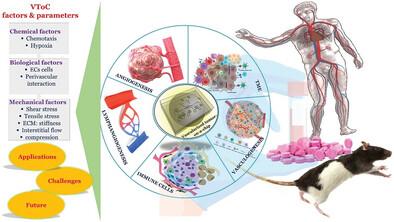当前位置:
X-MOL 学术
›
Adv. Therap.
›
论文详情
Our official English website, www.x-mol.net, welcomes your feedback! (Note: you will need to create a separate account there.)
An Overview of Advancements and Technologies in Vascularization Strategies for Tumor-On-A-Chip Models
Advanced Therapeutics ( IF 4.6 ) Pub Date : 2024-02-22 , DOI: 10.1002/adtp.202300410 Pratibha Parihar 1 , Naina Sunildutt 1 , Chethikkattuveli Salih Abdul Rahim 2 , Anupama Samantasinghar 1 , Jong Hwan Lim 1 , Kyung Hyun Choi 1
Advanced Therapeutics ( IF 4.6 ) Pub Date : 2024-02-22 , DOI: 10.1002/adtp.202300410 Pratibha Parihar 1 , Naina Sunildutt 1 , Chethikkattuveli Salih Abdul Rahim 2 , Anupama Samantasinghar 1 , Jong Hwan Lim 1 , Kyung Hyun Choi 1
Affiliation

|
Vascularized tumor on a chip (VToC) entail emulating intricate microvascular networks like those observed in tumors through microfluidic devices, which are meticulously designed to offer a faithful representation of cancer in vitro, exploration of tumor biology, evaluation of drug efficacy, and anticipation of patient responses to therapies. Compared to conventional ones, VToC systems hold advantages by creating a milieu where physiological conditions for investigating tumor–host interactions are pivotal in tumor advancement/therapy resilience. Nevertheless, VToC models confront limitations encompassing vascular network replication, biological fidelity, mechanical/chemical integrity, and intricacies of architectural design. Thus, drawbacks inherent to prevailing VToC models’ intricacies, attributes, and vascular network establishment are imperative. This systematic review focuses on the recent advancements, technologies explored for incorporating VToC models, and vascularization approaches for investigation, and factors/parameters affecting complex tumor microenvironments in VToC models, along with the futuristic approach for the design strategies, fabrication techniques, understanding of vascular network, also VToC models with spheroid. A comprehensive analysis of VToC based on their limitations for a practical approach highlights the promising strategies for possible applications. This will be essential regarding a complete overview of VToC models and the future direction toward developing efficient VToC models compared to the state-of-the-art VToC.
中文翻译:

芯片肿瘤模型血管化策略的进展和技术概述
芯片上的血管化肿瘤 (VToC) 需要通过微流控装置模拟复杂的微血管网络,就像在肿瘤中观察到的那样,这些微血管网络经过精心设计,可忠实地呈现体外癌症、探索肿瘤生物学、评估药物疗效以及对患者的预期对治疗的反应。与传统系统相比,VToC 系统具有优势,因为它创造了一个环境,在该环境中,研究肿瘤与宿主相互作用的生理条件对于肿瘤进展/治疗弹性至关重要。然而,VToC 模型面临着血管网络复制、生物保真度、机械/化学完整性和复杂的架构设计等局限性。因此,流行的 VToC 模型的复杂性、属性和血管网络建立所固有的缺陷势在必行。本系统综述重点关注最新进展、整合 VToC 模型的技术探索、研究的血管化方法、影响 VToC 模型中复杂肿瘤微环境的因素/参数,以及设计策略、制造技术、血管理解的未来方法网络,还有带有球体的 VToC 模型。基于 VToC 实用方法的局限性的综合分析突出了可能应用的有前景的策略。这对于全面概述 VToC 模型以及开发高效 VToC 模型(与最先进的 VToC 相比)的未来方向至关重要。
更新日期:2024-02-22
中文翻译:

芯片肿瘤模型血管化策略的进展和技术概述
芯片上的血管化肿瘤 (VToC) 需要通过微流控装置模拟复杂的微血管网络,就像在肿瘤中观察到的那样,这些微血管网络经过精心设计,可忠实地呈现体外癌症、探索肿瘤生物学、评估药物疗效以及对患者的预期对治疗的反应。与传统系统相比,VToC 系统具有优势,因为它创造了一个环境,在该环境中,研究肿瘤与宿主相互作用的生理条件对于肿瘤进展/治疗弹性至关重要。然而,VToC 模型面临着血管网络复制、生物保真度、机械/化学完整性和复杂的架构设计等局限性。因此,流行的 VToC 模型的复杂性、属性和血管网络建立所固有的缺陷势在必行。本系统综述重点关注最新进展、整合 VToC 模型的技术探索、研究的血管化方法、影响 VToC 模型中复杂肿瘤微环境的因素/参数,以及设计策略、制造技术、血管理解的未来方法网络,还有带有球体的 VToC 模型。基于 VToC 实用方法的局限性的综合分析突出了可能应用的有前景的策略。这对于全面概述 VToC 模型以及开发高效 VToC 模型(与最先进的 VToC 相比)的未来方向至关重要。



























 京公网安备 11010802027423号
京公网安备 11010802027423号